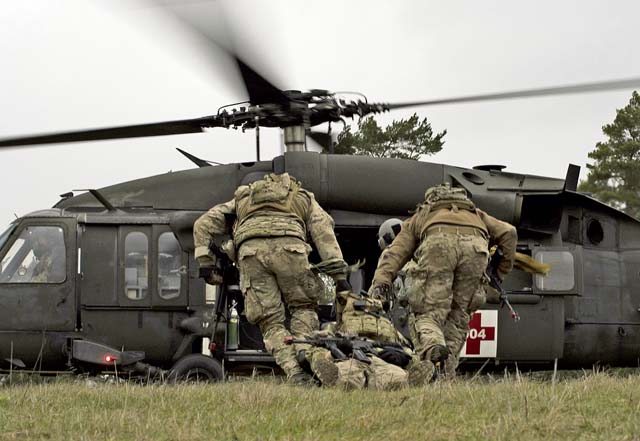
He tries to ignore the silent trickle of rain that falls down his face and focuses on the rapid bursts of gunfire in the distance; he knows that he and his Airmen will be found soon.
However, that concentration is short-lived as a deafening gust of wind erupts from above and the command “Get him to the helicopter!” is yelled by his team.
Unable to move due to his wounds, his comrades grab his bulletproof vest and sprint toward the UH-60 Black Hawk for medical evacuation, all while evading the barrage of gun fire.
The mission was a training scenario held Feb. 8 through 9 at U.S. Army Garrison Bavaria in Vilseck, Germany, to prepare 2nd Air Support Operations Squadron Airmen for real-world operations.
The 2nd ASOS is a combat support unit, and their role is to provide tactical command and control of airpower assets to the ground commander for combat missions.
“In the moments where bullets can’t get the job done is where we come in,” said Senior Airman Martin Dietrich, 2nd ASOS tactical air control party. “If there is a building full of targets, I can call for close air support and that obstacle is cleared almost immediately.”
To further improve their skills, half of the Airmen took the role of opposing forces to ensure their wingmen faced a formable challenge.
“At first, it was pretty difficult to stay focused while running around, taking cover and searching for the enemy,” Dietrich said. “But after a while, it became white noise, and I was able to choose what aircraft needs to take out what targets and help us move through the objective area.”
By focusing on various aspects of what they could expect during operations, both the experienced and unfamiliar Airmen gained something to improve their proficiency.
“Conducting training in an urban environment forced young TACPs like me, along with the more experienced, to think outside the box,” Dietrich said. “Even though rounds are going off around us and smoke grenades are clouding the battlefield, there can’t be any mistakes when close air support is called in, especially when we are near the targets.”
Having the ability to change lives with a single call could be a daunting responsibility, but for one TACP, it was the perfect challenge.
“When I joined the military I wanted something that would test my skills and make my family proud,” said Senior Airman Ericson Galinato, 2nd ASOS TACP. “The answer I found was to be part of the ASOS community, and here I am now at 24 years old in charge of multimillion dollar equipment and making the battlefield safer for us and our allies.”
Though it was his loved ones that helped Galinato reach his goal, he explains it is the support from his new family that inspired him to achieve new heights.
“We are around each other so much it feels more like a family than an office,” Galinato said. “We constantly push each other to be better, and it’s because of that guidance (I have grown).”
While there will be times a TACP or joint terminal attack controller could be out in the field alone, they can always rely on training and experiences shared by their peers to strike with fury in the battlefield.


